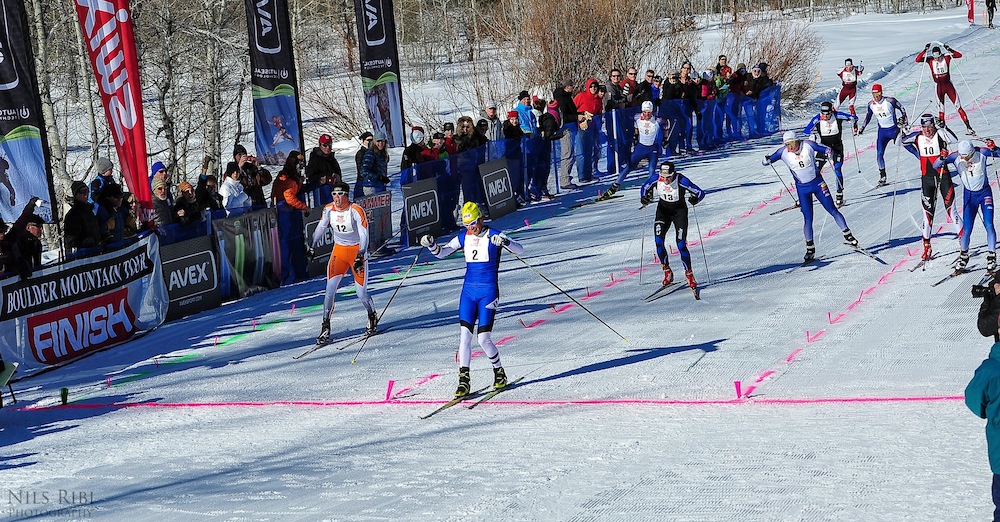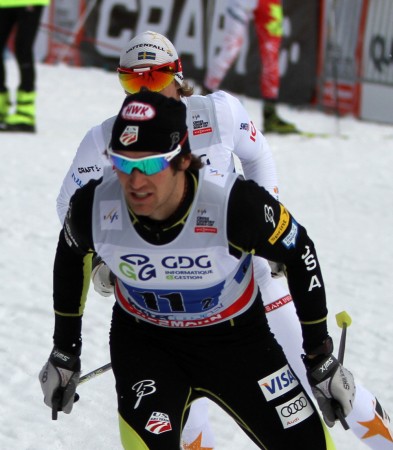
Sylvan Ellefson began last season in Europe on a gamble: if he put everything together at the right time, he might race well enough on the World Cup in Period 1 to qualify for World Championships. As the SuperTour leader at the end of the 2011/2012 season, the chance to enter top-level international races before the New Year was his for the taking.
Rather than play it safe at home, where lower FIS points might be easier to come by, Ellefson and his coaches at Ski & Snowboard Club Vail’s Team HomeGrown decided he couldn’t let the opportunity to go to waste. As the 26-year-old explained before last season began, “My ultimate goal is to progress U.S. skiing and kind of help the U.S. men to get to that next level. I think if I were to stay home that would be a little bit of a disservice to that.”

It was a new position for Ellefson to be in. With a huge jump forward in 2011, he earned his first World Cup starts in February and March of 2012, where he reached as high as 43rd in the 15 k skate in Rybinsk, Russia. Upon returning to the U.S. he fought back to the top of the SuperTour on a sprained ankle at Spring Series and, once he settled on the decision to go back to Europe, set his sights on a top-30 in his second World Cup stint and on World Championships in Val di Fiemme, Italy.
Instead, Ellefson got sick in the fall and never quite got up to speed in the Scandinavian World Cups. He had to drop out of the 30 k skiathlon in Canmore and his top finish for the period was a 57th in Quebec City sprint. It took Ellefson until just after U.S. Nationals to return to form and start winning races again, by which point his chance to qualify for World Championships had essentially closed and his absence from the domestic circuit all fall put him behind in SuperTour points.
From the perspective of his World Championships ambitions, the gamble in Europe didn’t play out the way Ellefson would have liked. Still, he says he’s happy he used the World Cup opportunity to build up his international experience and continue learning. There’s another season up ahead, and Ellefson is just as motivated as ever.
“I think it’s good to get a feeling of what all those periods are like,” he said on the phone last week from Bend, Ore. “Some people come into the season really fit and others work their way in. Obviously I wanted to be skiing fast [early] but I had a whole season ahead of me. To be skiing the first period in Sweden, Finland and Canada was just to see if I could improve my World Cup results from the season before.”
Taken as a whole, Ellefson thinks his 2012/2013 was comparable season to the one before it, despite spending different parts of the calendar year in Europe.
“It’s funny to compare my season from two years ago, where I skied basically the second half on the World Cup, and then last year, where I spent a quarter of my season on the World Cup,” Ellefson said. “To me, it seemed like a similar year. Obviously the FIS points in this country are a little skewed, but if they’re an objective measure my skiing was pretty much the same.”
This fall, Ellefson will be back where he first started to break through two years ago, at the Montana SuperTours in November and December.
“Now it’s a whole new ball game,” he said. “I’m back on the SuperTour this fall and I’m really looking forward to it. If I had it my way I’d be back over [in Europe], but for me to take advantage of what I can over here and…hopefully start racking up some good results this fall will be really important.”
Ellefson plans to use the domestic circuit and his comfort level with racing in the U.S. to keep moving forward next year. He carries a good amount of momentum with him from the spring; he had to drop out of the 50 k classic at U.S. Distance Championships after a crash, but a fourth-place finish in the 15 k classic a few days prior was his best result for the end of the season. And fourth in the overall mini-tour was, by his own assessment, “good for me; a good way to finish off the season.”
The men’s Continental Cup start spot on the World Cup, meanwhile, belongs to Mikey Sinnott (Sun Valley Ski Education Foundation) this fall, who stood atop the SuperTour standings at the end of last season. Sinnott’s own journey back to the World Cup underscores how difficult it is for athletes outside the U.S. Ski Team’s World Cup squad to put together consecutive appearances on the circuit. Excluding Canmore, Sinnott was last on the World Cup as the domestic distance leader in the spring of 2012, and it’s taken him the full cycle of a season to earn his way back in the fall of 2013. Torin Koos, similarly, won’t follow up his recent Period 4 World Cup appearance with an immediate return, and will likely be in the U.S. this fall fighting Ellefson for a trip back.

Moving forward, one of Ellefson’s preliminary goals is to reclaim the SuperTour leadership. But his real ambitions lie far beyond a return to the World Cup.
“There’s a lot of guys in my exact spot who’ve done some awesome training over the years and just want to go kick some butt on the World Cup and hopefully the Olympics,” Ellefson said.
Sochi is the focal point for many athletes this year, and Ellefson wants to both qualify and perform well there. “It’s not like I just want to go; I want to go and have a result,” he said.
“If I am the SuperTour leader going into the second period that would be helpful to go over to Europe before, and hopefully I am named to the Olympic team and that’ll give me time before those races start in February.”
Only four athletes per country are allowed to compete in each event at the Olympics, and Ellefson knows the battle to get there will be a tough one. At the USST’s Bend training camp last month, he was training right alongside the competition. He rattled off the names of a dozen skiers who were there working as hard as he was.
“The guys that are here… all of them are putting in tons and tons of work for this year, as we always do,” Ellefson said. “It’s going to be exciting. It’s a really exciting year to watch all of us duke it out.”
In the meantime, his summer training will be very similar to what it’s been for the last few years. Ellefson is still skiing in Bend at the moment with his Vail teammates and will be based out of Colorado for most of the off-season, with plans to travel to Lake Placid, Park City and Canmore for periodic training camps.
At this point in his career, Ellefson knows from experience what it takes to race well, and consistently so, for a several-month stretch. Domestic racers with Sochi ambitions will have to ski fast from the first race in West Yellowstone through the beginning of the winter, and the season only intensifies from there.
“Different skiers have good years every year,” Ellefson said. “It’s hard to forecast who’s going to be skiing fastest this season at the right times.”
Audrey Mangan
Audrey Mangan (@audreymangan) is an Associate Editor at FasterSkier and lives in Colorado. She learned to love skiing at home in Western New York.



